Chinese Money: How Much Money is Enough for a China Trip
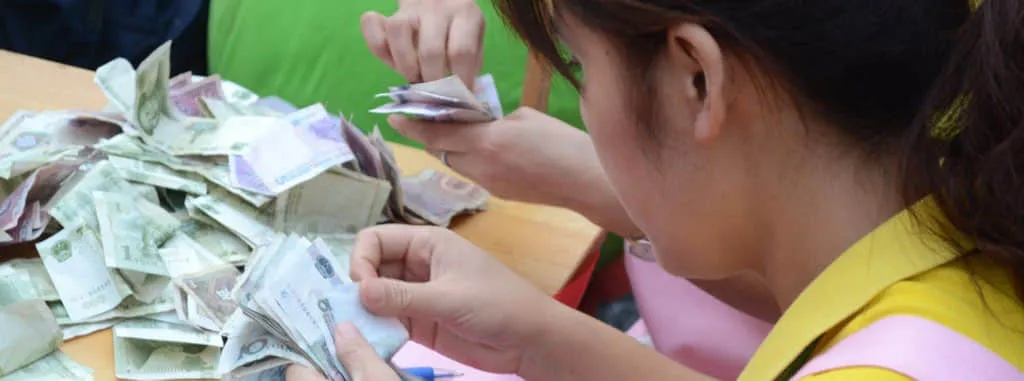
We should never take money for granted – because without it your holiday would be spoilt. On your holiday in China you need to understand the value of the money in your hand in order to use it well.
Table of Contents
- What is the Chinese "dollar"? What currency does China use?
- An In-Depth Look at the Chinese Yuan Renminbi
- Is Cash still the King in China?
- What is Chinese money worth compared to other currencies?
-
FAQs for preparing a trip to China:
- How much cash should I bring when I fly to China?
- Will my credit card be accepted?
- Can I use Travelers’ Checks?
- Can I tip my tour guide and driver with US dollars?
- Is there counterfeit money in China?
- Where is the best place to exchange Chinese currency?
- How do I check a RMB bank note to make sure it's real?
- What is the schedule for Chinese banks?
- What are the other payment methods in China?
What is the Chinese "dollar"? What currency does China use?
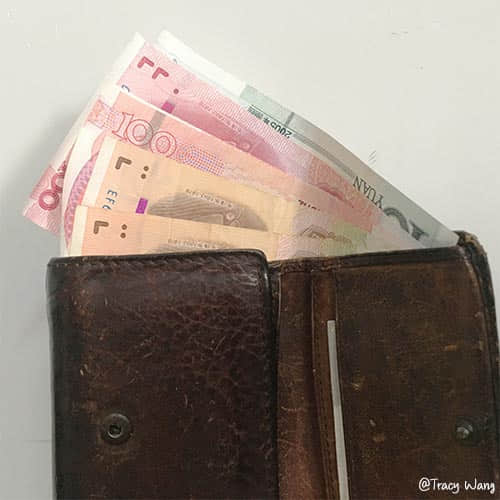
The main unit of Chinese money, what we could call the Chinese “dollar”, has several interchangeable names, which can be confusing.
You may hear Chinese money referred to as Renminbi (人民币), or RMB, which means simply “Peoples Currency”. So in this case you may see prices quoted like this: RMB 10
You may also hear the Chinese dollar referred to as “Yuan” (元). The abbreviation CNY is used, sometimes written as CN¥ or just ¥, and so you may see the same prices quoted as CNY 10.
You will commonly hear people use the word “kwai”, which is still exactly the same thing. The price would be stated as “10 kwai”.
There are also names for denominations smaller than an RMB / Yuan / kwai:
Jiao or mao are both the name for a tenth of a yuan. A fen is a hundredth of a yuan.
What are the denominator, buying everything with “plastic” on your bank cards. However, in China, you need to be comfortable handling cash. Your card will be useful mostly for withdrawing cash from ATMs.
If you take cash out of an ATM you will only receive red RMB 100 notes. However, this is too large a denomination for most transactions, so you will need to get hold of some of the others:
There is an RMB 50 note, which is a greenish blue, and an RMB 20 note which is brown. The RMB 10 note is blue, and the RMB 5 is purple. There is also a olive green RMB 1 note. All of these small denominations will be most useful at street stalls.
You will also find uses for the 1 jiao coin and note, and the 5 jiao coin and note. Occasionally you will even come across fen notes and coins.
An In-Depth Look at the Chinese Yuan Renminbi
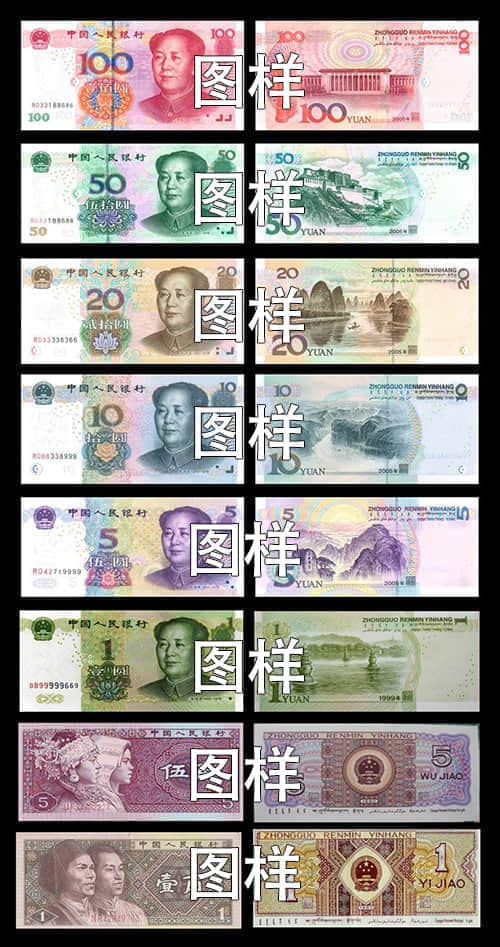
The renminbi (literally "people's currency") is the legal tender in the mainland of the People's Republic of China. It is issued by the People's Bank of China (PBOC, central bank). The official abbreviation is CNY, although also commonly abbreviated as "RMB". China has experienced rapid economic growth over the past few decades, becoming the second-largest economy in the world. This growth has led to an increase in China's influence and trade volume, making the yuan more significant in global transactions. In November 2015, the International Monetary Fund (IMF) made an announcement acknowledging the increased importance of the renminbi. As a result, the renminbi was added to the IMF's reserve currencies, joining the ranks of the U.S. dollar, euro, British pound sterling, and Japanese yen. These reserve currencies are utilized for intergovernmental loans and are part of the IMF's Special Drawing Rights (SDR) system. The renminbi officially attained its new status in late 2016.
Renminbi (RMB) vs. Chinese Yuan(CNY): What’s the Difference?
In everyday usage, the terms "Renminbi" and "Chinese Yuan" are often used interchangeably to refer to the currency of China. However, there is a subtle difference between the two:
- Renminbi (RMB): Renminbi is the official currency of China. The term "Renminbi" translates to "people's currency" in English. It encompasses the broader currency system, which includes banknotes, coins, and digital currency in China.
- Chinese Yuan (CNY): The term "Yuan" specifically refers to the basic unit of the Renminbi currency. 1 Yuan is equal to 10 Jiao or 100 Fen. When people say "Chinese Yuan," they are typically referring to the basic unit of the Renminbi currency used in everyday transactions.
To summarize, Renminbi is the official currency of China, while Yuan is the basic unit of the Renminbi currency. So, while they are often used interchangeably, Renminbi refers to the broader currency system, while Yuan specifically denotes the basic unit of the currency.
Bank Notes
Chinese paper money usually comes in 1 fen (rare), 2 fen (rare),5 fen (very rare), 1 jiao, 2 jiao, 5 jiao, 1 yuan, 2 yuan, 5 yuan,10 yuan, 20 yuan, 50 yuan and 100 yuan.
One yuan is divided into 10 jiao. One jiao is divided into 10 fen, pennies in English. The largest denomination of the renminbi is the 100 yuan note. The smallest is the 1 fen coin or note. RMB is issued both in notes and coins. The paper denominations include 100, 50, 20, 10, 5, 2 and 1 yuan; 5, 2 and 1 jiao; and 5, 2 and 1 fen. The denominations of coins are 1 yuan; 5, 2 and 1 jiao; and 5,2 and 1 fen.
In spoken Chinese, "yuan" is often called as "kuai" and the "jiao" as "mao". Fen-denomination RMB is rarely used, except at supermarkets.
Yuan (CNY/RMB): Yuan is the base unit of the Chinese currency. It is often referred to as "yuan" in English and carries the symbol "¥". When you see a price or amount written in yuan, it typically refers to a whole number amount. For example, ¥10 or ¥100. The different denominations of yuan are:
| ¥1 (1 yuan) |
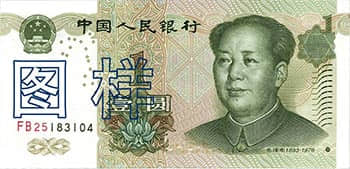
|
| ¥5 (5 yuan) |
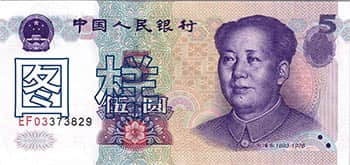
|
| ¥10 (10 yuan) |

|
| ¥20 (20 yuan) |
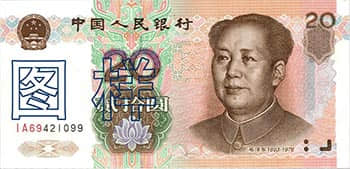
|
| ¥50 (50 yuan) |
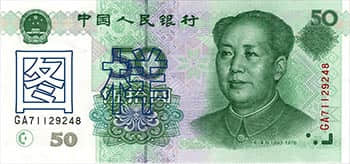
|
| ¥100 (100 yuan) |

|
Jiao: Jiao is the subunit of the yuan, and it is equal to one-tenth of a yuan. It is often referred to as "mao". One yuan is equivalent to ten jiao. However, in practice, jiao is rarely used in transactions anymore, and prices are commonly quoted and paid in yuan. There are three kinds of Jiaos, Yi jiao(one jiao), er jiao (two jiao) and wu jiao(five jiao).
Fen: Fen is the smallest subunit of the yuan, and it is equal to one-hundredth of a yuan. Similar to jiao, the fen is seldom used in everyday transactions. Instead, prices are rounded to the nearest jiao or yuan. There are three kinds of Fens, Yi fen(one fen), er fen (two fen) and wu fen(five fen).
To simplify, you can think of yuan as dollars, jiao as dimes, and fen as pennies. While yuan is the main unit, jiao and fen help to differentiate smaller amounts within the currency system.
Coins
The Renminbi is issued in the form of banknotes and coins. Here are the commonly used coins of RMB:
| 1 Fen (分) - This is the smallest denomination and not frequently used in everyday transactions. |
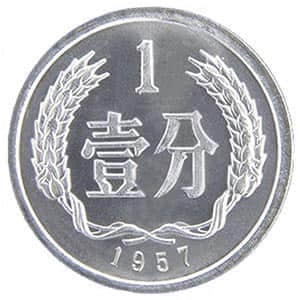
|
| 5 Fen (分) - Slightly larger than the 1 Fen coin, it is also not commonly used. |
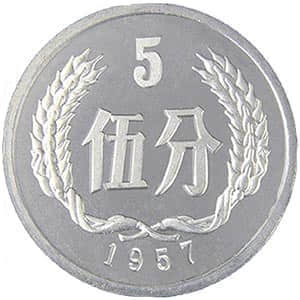
|
| 1 Jiao (角) - Equal to 10 Fen, this coin features a round shape with a square hole in the center. It is commonly used for small transactions. |
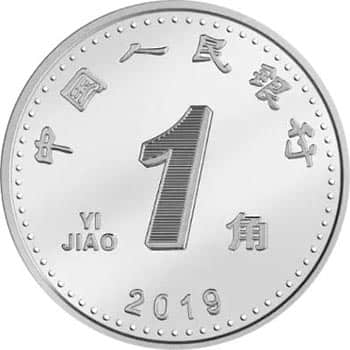
|
| 5 Jiao (角) - Equivalent to 0.5 Yuan, this coin shares the same design as the 1 Jiao coin but is larger in size. |

|
| 1 Yuan (元) - The most commonly used coin, it features a round shape with a square hole in the center. It is equivalent to 10 Jiao or 100 Fen. |
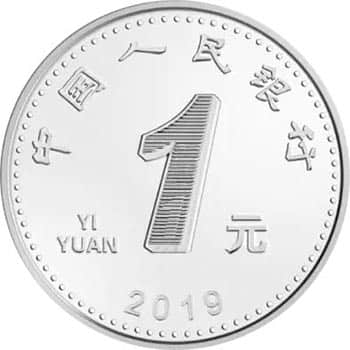
|
Please note that while these coins are still in circulation, electronic payments and mobile payment apps are widely used in China, reducing the reliance on physical coins and banknotes for daily transactions.
Key Chinese characters that help you to understand the money:
When closely examining Chinese currency, you will notice a combination of Arabic numerals and intricate Chinese character numbers. The main purpose of utilizing complex Chinese character numbers on Chinese banknotes is to include special fraud-resistant characters. These special characters, exemplified by "壹圆" instead of "一元" for "one yuan," are purposely designed to increase the difficulty of counterfeiting. Their intricate nature makes them more challenging to replicate accurately. By incorporating these distinct characters on banknotes, the Chinese government aims to enhance security measures, combat counterfeiting, and protect the integrity of the currency.
| Chinese Character | pīnyīn | Meaning |
|---|---|---|
| 壹 | yī | One |
| 贰 | èr | Two |
| 伍 | wǔ | Five |
| 拾 | shí | Ten |
| 贰拾 | èrshí | Twenty |
| 伍拾 | wǔshí | Fifty |
| 壹佰 | yībǎi | One hundred |
| 圆 | yuán | Yuan |
| 角 | jiǎo | Jiao (one-tenth of a yuan) |
| 分 | fèn | Fen (one-hundredth of a yuan) |
History of Chinese Yuan
The history of the Renminbi (RMB) dates back to the establishment of the People's Bank of China (PBOC) in December 1948. Here are some key milestones in the history of the RMB.
Introduction and Early Years (1948-1955)

The People's Bank of China (PBOC) introduced the Renminbi currency on December 1, 1948, as the "Renmin Yinhang Quan" or currency of the People's Bank of China. This was during a period when the Communist Party of China was engaged in a civil war with the Chinese Nationalist Party, which had its own currency. To stabilize the areas held by the Communist Party, the Renminbi was first issued, leading to the circulation of as many as 62 versions of the currency including paper notes and coins issued by different regions. This strategic move played a role in the Communist Party's ultimate victory. The largest denomination of this set of renminbi is the 50000 yuan note. The smallest is the 1 yuan note. There were no coins issued only bank note.
The Currency’s Second Issue (1955)
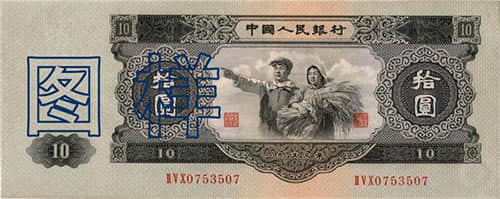
Since the first series had diverse in quality and design due to warfare, in March 1955, the Chinese government issued second series of RMB . And the government officially adopted the Yuan as the basic unit of the Renminbi and introduced the "Renmin Yinhang Piaoju" (People's Bank of China note) as the unified currency. This set of banknotes decreased the nominal value and underwent a conversion of 1:10000 compared to the initial series. Additionally, it included Mongolian, Uygur, and Tibetan languages, indicating the growing significance of national unity to the government. It is noteworthy that the production of the first and second series of the Renminbi was accomplished with the help of Soviet technology. This indicates that the newly formed China lacked its own counterfeiting technology and had to rely on the support of the Soviet Union. The largest denomination of this set of renminbi is the 10 yuan note. The smallest is the 1 fen note. Coins with denominations of 1 fen, 2 fen and 5 fen were issued.
The Currency’s Third Issue (1962)

China and the Soviet Union politically broken up in the 1950s, which forced China to invent its own counterfeiting technology which later was used to produce the third series of RMB. China now can also produce high quality currency paper. The third series of RMB used multi-color printing technology and used hand-engraved printing plates for the first time. Due to the implementation of planned economy, coupons were issued by government as certificates to buy daily supplies from the market, which can be seen as temporary banknotes during a particular period of China’s contemporary history. The largest denomination of this set of renminbi is the 10 yuan note. The smallest is the 1 Jiao note and coin.
The Currency’s Fourth Issue (1987)
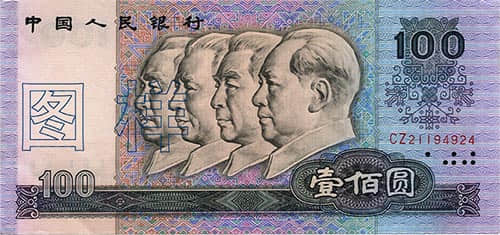
In 1987, a fourth series of RMB was issued featuring a watermark, magnetic ink, and fluorescent ink. The fourth series of the Renminbi was issued in response to the growth of the economy, the increase in retail sales of goods, and the rising demand for currency. With the implementation of the reforms and opening-up policy in 1980, China's national economy experienced rapid development, and the commodity economy in urban and rural areas became increasingly active, leading to a substantial increase in retail sales of goods. As a result, it was necessary not only to adjust the overall volume of currency issuance accordingly but also to adapt the denomination structure to meet the requirements of the growing economy and its changing needs. The design theme changed to national unity in China. Therefore, the whole sets of RMB used head portraits of people from different nationalities. The largest denomination of this set of renminbi is the 100 yuan note. The smallest is the 1 Jiao note and coin.
The Currency’s Fifth Issue (1999)
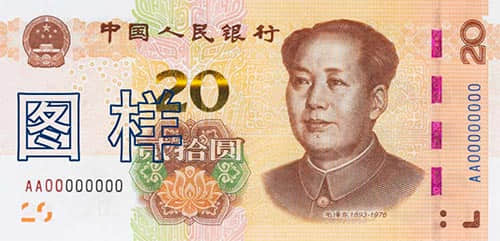
On October 1, 1999, the People's Bank of China issued the fifth set of RMB in eight denominations: 100 yuan, 50 yuan, 20 yuan, 10 yuan, 5 yuan, 1 yuan, 5 mao and 1 mao (a mao is one-tenth of a yuan). All of the denominations of the fifth set of RMB adopt a head portrait of Chairman Mao Zedong in the early days of the founding of the People's Republic of China. Along the bottom of the notes there is a pattern of the famous flowers of China. The main patterns on the back show the Great Hall of the People, the Potala Palace, the landscape of Guilin, the Three Gorges of the Yangtze River, Mount Tai and Hangzhou West Lake. Through the selection of representative patterns with ethnic characteristics, China's long history and magnificent scenery have been fully demonstrated and its great national culture has been promoted.
Renminbi as an International Currency
In recent years, China has made efforts to internationalize the Renminbi to promote its use in global trade and finance. The Renminbi was included in the International Monetary Fund's (IMF) Special Drawing Rights basket of currencies in 2016, recognizing its significance on the international stage.
What is Waihuiquan (外汇兑换券)?
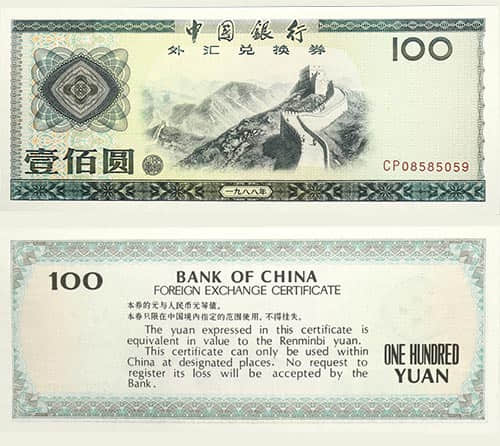
pick #FX9 1988 100 Yuan -Wmk:National Badge
S/N CP08585059 - Bank of China
The Waihuiquan refers to Foreign Exchange Certificates (FECs). FECs were a form of currency used in China from the 1980 until the early 1994. They were primarily used by foreigners and citizens of Hong Kong, Macau, and Taiwan for various transactions within mainland China. The different denominations are Yi jiao, wu jiao, one yuan, five yuan, ten yuan , fifty yuan and one hundred yuan.
During this period, China had restrictions on the use of its national currency, the Renminbi (RMB), by foreigners. To facilitate economic interactions with foreigners, the Chinese government introduced FECs. These certificates could be obtained in exchange for hard currencies, such as US dollars.
FECs were mainly used in designated foreign exchange shops where foreigners could purchase goods and services. Additionally, many hotels, restaurants, and stores specifically catering to the needs of foreigners accepted FECs as payment. This system helped manage foreign exchange transactions and accommodate the increasing number of foreigners visiting or residing in China.
However, after economic reforms were introduced in the early 1990s, China gradually liberalized its currency regulations. As a result, the use of FECs declined, and they were eventually phased out. Foreigners and Chinese citizens alike could then directly use the Renminbi for most transactions in China.
Is Cash still the King in China?
Cash has traditionally been widely used in China for day-to-day transactions, earning the phrase "cash is king" in the country. However, over the last few years, mobile payment has sprung up in all Chinese cities as a preference over cash and cards. Mobile payments are used when people buy goods or services from various businesses ranging from street vendors, supermarket chains to fancy shopping centers. Electronic payments are mainly processed through China’s Alipay and WeChat Pay apps. By linking credit and debit cards with personal accounts on the two apps, people could transfer money and complete payments with a few taps of their fingers.
What is Chinese money worth compared to other currencies?
Cash has traditionally been widely used in China for day-to-day transactions, earning the phrase "cash is king" in the country. However, over the last few years, mobile payment has sprung up in all Chinese cities as a preference over cash and cards. Mobile payments are used when people buy goods or services from various businesses ranging from street vendors, supermarket chains to fancy shopping centers. Electronic payments are mainly processed through China’s Alipay and WeChat Pay apps. By linking credit and debit cards with personal accounts on the two apps, people could transfer money and complete payments with a few taps of their fingers.
Obviously exchange rates are changing all the time, and vary from one currency to another. However, as a general rule there are about CNY 5 – 8 to each western dollar. You can check the up to date exchange rate here:
For example, at this particular time
- The US dollar (USD) converts to CNY 6.2
- The Canadian dollar (CAD) converts to CNY 4.9
- The Euro (EUR) to CNY 7.7
- The British Pound (GBP) converts to CNY 8.8
- The Australian Dollar (AUD) converts to CNY 4.8
Sometimes it’s easier to consider the CNY 100 note in terms of your own currency. At the time of the above exchange rate, the CNY 100 note was worth about $16 (USD), or €13 (EUR), or £12 (GBP), or $20(AUD).
Using the same calculation, you can easily be aware of the value of a single Yuan in your own currency. For example, at the rate mentioned above, one Yuan is worth 15 ₵ (USD).
You may sometimes notice that items are a similar number of yuan (RMB / CNY) as you would expect to pay in your home dollars. For example, a $30 shirt may cost CNY 30. Clearly things are much cheaper to buy in China.
How much is 100 Yuan worth? An overnight room in a hostel usually costs about 80-100 yuan. In the local market, you can pick up 2 or 3 T-shirts, and some of the souvenirs such as local specialties and decorations all for less than 100 yuan. A quick meal is about 20 yuan, and you can use 100 yuan to buy 5 quick meals, or 12 cans of beer, or have a hot pot meal.
Food is especially cheap in China, partly because wages are so much lower. But generally everything is relatively cheap. Enjoy your wonderful holiday!
FAQs for preparing a trip to China:
1. How much cash should I bring when I fly to China?
Firstly, you cannot bring in more than $5,000 USD, or CNY 20,000, without declaring it and having the relevant paperwork.
You should only bring enough cash for your immediate needs, for taxi’s, snacks, and the like, for the first day or two. For many people that means CNY200-300, others feel more comfortable with CNY 500. You can change a little money at your bank before you leave home, or change money at the hotel, or draw out some money from an ATM in the airport.
Once you are settled into your hotel, you can draw money out from ATMs every few days as you need it.
2. Will my credit card be accepted?
You need to inform your bank before you go to China so they are not worried when charges are arriving from China.
If you have one of the common cards (Visa, MasterCard, Amex etc.) then your card will be accepted by ATMs.
You can use your credit card in most hotels and shops, especially in the big cities, but China is more of a cash economy and you would do better to be ready with cash, especially some of the smaller denominations to use at stalls and on public transport.
3. Can I use Travelers’ Checks?
Travelers’ Checks can be changed in some big banks and hotels, but they are actually far less convenient than credit cards. So not recommended.
4. Can I tip my tour guide and driver with US dollars?
As having been internationalized, tipping is now expected in China. You can tip in US dollars, as they can be quite easily exchanged, but you could just as easily tip in Chinese Yuan.
Some people like to also bring a number of small gifts from their homeland to hand to special people who have given loyal service.
5. Is there counterfeit money in China?
Be aware that there are counterfeit bills in circulation in China, especially the RMB 100 and RMB 50, so be careful. When you hand over your money in a Chinese shop or at a stall, you may observe the vendor examining it carefully to make sure that it is not counterfeit. They may simply rub a coin over it, or run it through a machine. Watch carefully to make sure they don’t switch the note, then hand back a counterfeit saying they can’t accept it. Money from ATMs will be okay, but any other time you are handed cash it may be worth feeling it carefully and comparing it with other notes (to make sure it is not too thin or smooth). You can also choose to reject a note and ask for another.
6. Where is the best place to exchange Chinese currency?
The best place to exchange Chinese currency (Renminbi) may vary depending on your location and personal preferences. Here are some common options to consider:
Local banks: Banks often provide currency exchange services, including Chinese currency. They are generally considered reliable and secure. However, exchange rates may not always be as competitive as other options.
Currency exchange offices: Specialized currency exchange offices or booths can be found in many cities and tourist areas. These establishments are dedicated to currency exchange and often offer competitive rates. However, it's important to verify their reputation and ensure they are authorized and trustworthy.
Airports: International airports usually have currency exchange counters where you can exchange your currency. While convenient, exchange rates at airports might not be as favorable due to higher operating costs and fees.
Online platforms: Some online platforms offer currency exchange services, allowing you to order Chinese currency online and have it delivered to your location or pick it up at a designated location. Compare rates and read reviews of reputable online platforms before using this option.
Local markets: In China, local markets or street vendors may also provide currency exchange services. However, it's crucial to exercise caution and ensure that the service is trustworthy and the rates offered are fair.
When choosing a place to exchange Chinese currency, consider factors such as exchange rates, fees, convenience, security, and reputation. It's advisable to compare rates and reviews from different sources to get the best deal. Additionally, be mindful of any local regulations and requirements related to currency exchange in your area or the destination country.
7. How do I check a RMB bank note to make sure it's real?
To check whether a Chinese currency note is real and authentic, you can follow these steps:
Look for security features: Examine the security features implemented on the banknote. The RMB includes various anti-counterfeiting measures that help with identification. These features might vary depending on the denomination and edition of the note. Some common security features include holographic strips or patterns, color-shifting inks, watermarks, security threads, and raised printing.
Feel the texture: Genuine RMB notes have a distinct feel to them. The paper used for RMB notes is of high quality and has a unique texture. Counterfeit notes may often have a different feel, as they are typically printed on lower quality paper.
Check the watermark: Hold the banknote up against the light and look for the watermark. A watermark should be visible on the right side of the note when viewed from the front. It typically depicts the portrait matching the main portrait on the front.
Inspect the color-shifting ink: On the front of most RMB banknotes, you will find a denomination numeral that uses color-shifting ink. Tilt the note to see if the color changes. This feature is challenging to replicate accurately in counterfeit notes.
Verify the security thread: Most RMB notes have a metallic security thread embedded vertically in the banknote. The thread should be continuously visible when held up to the light. It usually contains text or patterns related to the denomination.
Examine the fine details: Pay attention to the fine details like intricate patterns, microprinting, and small letters or numbers. Counterfeit notes may lack the precision and clarity found in genuine RMB banknotes.
Compare with genuine banknotes: If you have access to a known genuine RMB banknote of the same denomination, visually compare it with the one you are inspecting. Look for any discrepancies in design, colors, or features.
Consult Chinese authorities: If you suspect a note is counterfeit or want further verification, you can reach out to the Chinese central bank or relevant law enforcement agencies for assistance. They can provide guidance or help determine the authenticity of a banknote.
Remember, these guidelines are not foolproof, and counterfeiters can become more sophisticated. When dealing with large sums or in a professional capacity, it's advisable to utilize additional methods or equipment to ascertain the authenticity of RMB banknotes.
8. What is the schedule for Chinese banks?
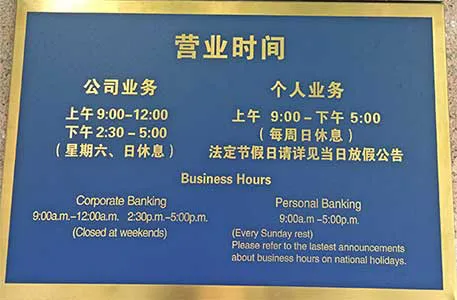
Bank of Communications: Guilin GaoXin Sub-Branch
Chinese banks normally open on Monday to Friday, and the working hours are 09:00 to 17:00, but ATMs are available 24 hours, seven days a week. Bank holidays are the same as Chinese official public holidays.
9. What are the other payment methods in China?
Mobile phone payments are widely used in China nowadays. Two Apps dominate the mobile payment system, which are Alipay and WeChat Pay (also known as Tenpay). Both of them need to connect with at least one Chinese bank card. When you open the App, the buyer can scan the seller’s Quick Response (QR) code to recognize and complete the payment. Another way is that the seller scans the buyer’s payment code on the App to deduce the payable amount on your mobile wallet.
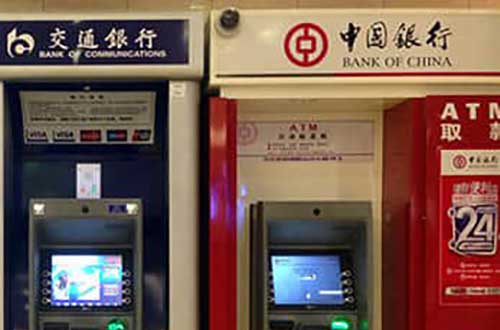 How to Use ATM in China
How to Use ATM in China 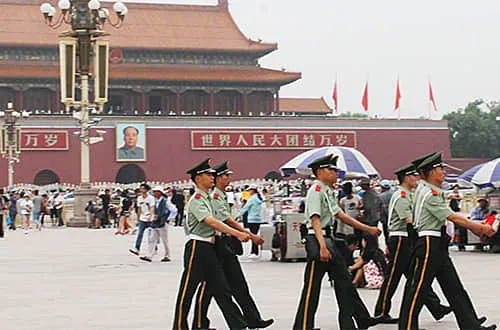 Is It Safe To Travel To China?
Is It Safe To Travel To China?  Summary of China Travel Tips
Summary of China Travel Tips 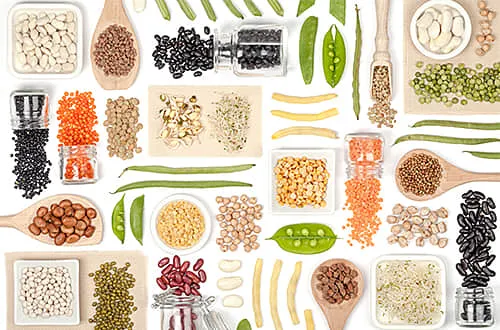 How can I travel safely if I have Allergies?
How can I travel safely if I have Allergies?